The Evolution of Whales
Based on November 2001 National Geographic Magazine, "The Evolution of Whales". Covering the Evolutionary Origins of Modern Whales and Dolphins. Reviewed, with some edits by Northeastern Ohio Universities College of Medicine, Dr. J.G.M. Thewissen, with additional comments by Edward T. Babinski, and revised text and art by Sharon Mooney. (All images reconstructed from National Geographic, are public access, though source and appropriate credits must be left intact.)
The Whale's Tale - research on whale evolution
Science News, Nov 6, 1999 by Richard Monastersky
Only 24 years after Charles Darwin rewrote the book of life with his theory of natural selection, a fellow Victorian scientist named William Flower trained this powerful new idea on one of the toughest problems in zoology: the whale. Natural historians had long before recognized that whales are mammals, but that was about as far as they had come in understanding the origins of cetaceans. How evolution had managed to craft such a unique beast presented a mystery as vast as the creature itself.
In 1883, Flower offered an idea that--on the face of it--seemed positively daft. The legless leviathans, he suggested, had evolved from mammals known as ungulates, a group whose best-known characteristic is a set of hoofed feet. In other words, dolphins, porpoises, humpbacks, orcas, and ail other whales are close kin of cows, horses, pigs, and related barnyard stock.
More than a century after Flower raised his audacious hypothesis, it no longer stirs even a whiff of controversy. Dozens of scientific studies over the past 3 decades have convinced biologists that cetaceans are the progeny of hoofed mammals. Yet the whale's story is far from finished.
Source: Research on Whale Evolution
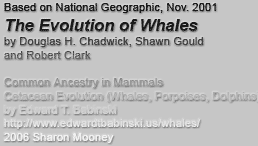 |
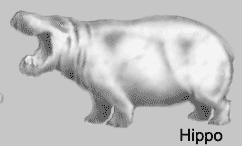 |
|
 |
||
 |
||
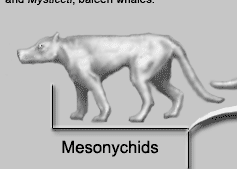 |
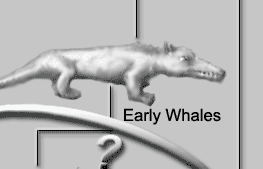 |
|
 |
||
Whales Closest Living Relative and Ancestors
Back To The Sea
The earliest known representatives of whales walked on land and were carnivores with fur and hooves. Their successors in the Eocene, likely evolved into squat and heavy-headed species, pursued an amphibious life in shallow water. Within ten million years these species' bodies were adapted to life in the ocean.
Which animals were the ancestors of whales?
Past discoveries of whale fossils have lent to the belief that long-extinct ungulates, called mesonychids, were ancestors or relatives of whales. Molecular data from DNA samples, indicate whales arose from artiodactyls, which include hippos, not mesonychids, and that hippos are in fact the closest living relatives to whales. Discoveries of ankle bones on early whales, lend credibility to the artiodactyl link. There now is also morphological support for the hippo link.
Paraphrased from National Geographic, November 2001, The Evolution of Whales--
Pakicetid fossils described in 2001 were important in determining what whales were related to. These fossils confirmed what was already suggested by scientists studying the DNA of modern whales: that whales’ closest relatives are even-toed ungulates (artiodactyls, such as pig, hippo, camel, deer, and cows)."
Source: Origin of Whales, Thewissen Lab Webpage
--
Outdated Model of Pakicetus Skull

1980's Pakicetus reconstruction (LEFT) compared with Pakicetus skull based on recently discovered fossils described in 2006"There are a number of reconstructions of entire Pakicetus skulls out there which were made in the mid-80s and are based on only a braincase and partial lower jaw (all that was available back then). The snout, nose, area of the eyes, and the area between the eyes in those reconstructed specimens was modeled after Protocetus. With the new material, it is clear that this reconstruction is incorrect about the position of the eyes, and the site of the nose opening."
- J.G.M. Thewissen
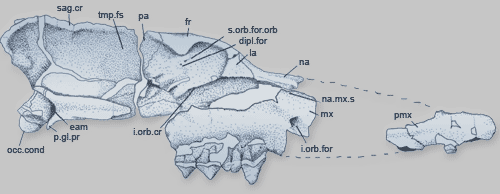
Anatomically correct Pakicetus skull
Source:Cranial Anatomy of Pakicetidae (Cetacea, Mammalia)
Sirpa Nummelai, S. Taseer Hussain, and J.G.M. Thewissen
Journal of Vertebrate Paleontology 26(3):746–759
September 2006, Society of Vertebrate Paleontology
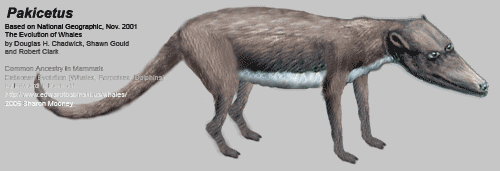
Pakicetus
50 million years ago
A Common Misconception
Pakicetus is a Middle Eocene archaeocete from the Kuldana Formation of Pakistan; it is currently the earliest known well-preserved cetacean. Until 2001, Pakicetus was known only from its skull, but recent finds in Pakistan have produced specimens that show very primitive characters in both the skull and the rest of the skeleton. These animals had relatively well developed limbs, but were aquatic.It was noted in November 2001 National Geographic, The Evolution of Whales page 66, Pakicetus was "known only from skull". Since the article was published, many more of the fossilized remains of Pakicetus have been recovered, (Nummela et al., 2006).
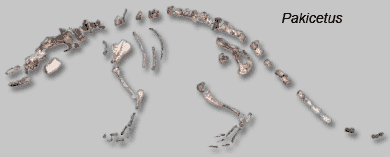
"Pakicetids did not look like whales at all, and resembled land mammals. However, the skulls of pakicetids have an ear region that is highly unusual in shape, and only resembles that of modern and fossil whales. These features are diagnostic for cetaceans, they are found in all cetaceans, and in no other animals. These features are the main reason why pakicetids are considered whales. In many other features, pakicetids are also similar to some whales, but those features are not shared by all whales. An example of the latter is the dentition. Pakicetid teeth look a lot like those of fossil whales, but are unlike those of modern whales. Pakicetids did not live in the sea. The rocks in which their fossils are preserved indicate that the bones were buried in a shallow stream, and that the climate was hot and dry. It is likely that pakicetids waded in these streams. Their bones are unusually thick, possibly an adaptation to make the animal heavier counteracting the buoyancy of the water."
Source: Thewissen Lab Webpage
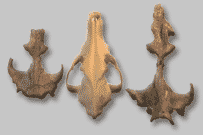
Pakicetus Skulls
The skulls of two pakicetid whales flank the skull of a modern coyote (Ichthyolestes on the left, Pakicetus on the right). These skulls were described by Thewissen et al. (2001) and Nummela et al. (2006). .
The family Pakicetidae (pakicetids in English) consists of three genera,
- Pakicetus
- Nalacetus, and
- Ichthyolestes
[image of Pakicetus and Ichthyolestes skeletons comparison, can be found here]Of these, Pakicetus and Nalacetus were the largest, and Ichthyolestes the smallest. In overall shape, these three are not very different. The skeleton of pakicetids was described by Thewissen et al. (2001). In evolutionary time, pakicetids were followed by ambulocetids.

An Accurate Reconstruction of Pakicetus
This sketch by Carl Buell, is based on all bones presently available for Pakicetus.
All information, including additional photography available at the Thewissen Lab webpage, Pakicetid, Whales Origin Research.
The author of the article in National Geographic Magazine, Evolution of Whales, discusses at length about witnessing humpback whales leaping near their boat, and comments "I wondered what the crews on whaling ships thought when they would occasionally haul aboard a fully grown adult with miniature legs sticking out from its flanks. Whether they knew it or not, they were looking at testimony to the origin of these mysterious marine giants."
Over 80 species are classified as whales, or as taxonomists prefer to call them, cetaceans, which originates from the Greek ketos for sea monster. Cetaceans are divided into two groups, the Mysticetes (baleen whales) which use comblike plates on the roofs of their mouths to strain food from the water. Some of these are the Blue whales, fin whales, bowheads, and most of the other large whales belong to this line, along with some smaller whales such as the minke whale and pygmy right whale.
Odontocetes, the toothed whales, include belugas, narwhals, sperm whales, pilot whales, and beaked whales, including dolphins and porpoises. Killer whales are the largest members of the dolphin family
The early Eocene epoch, which lasted from 55 million years ago to around 34 million years ago, is often called the dawn of the age of mammals, and when whales had their first known beginnings. Paleontologists can now trace the origins of whales through a series of fossil discoveries.
Blue whales, the largest of the cetaceans, are larger than any known dinosaur dimension, measuring up to as much as 100 feet, and weigh a third of a million pounds.
The author of National Geographic's Evolution of Whales, comments about his visit with Thewissen, in which he is handed the skull of one of the oldest known whales. "At first glance I thought he had handed me the head of a coyote." Remains of Pakicetus were discovered in the Himalayan foothills sediment. Judging by surrounding sediment, the creature lived as a land-dweller, among marsupials and squirrel-sized primates, our very early human ancestors.
The remains of Pakicetus are closely linked to river channels, which suggest the creature spent part time around and perhaps in water. Subtle clues in the anatomy of Pakicetus cause scientists to declare the creature an early whale. A combination of
- cusps on the molars teeth,
- One of the middle ear bones (the tympanic) which contains an s-shaped fold, as well as the
- positioning of other middle ear bones inside the skull.
These traits are absent in other known mammals, but are a signature of all later whales.
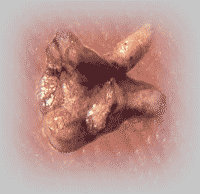
Middle ear bone (the incus) from a 50-million year old Pakicetid
"Beautifully Intermediate" says Dr. Thewissen, "It's structure helps answer how a land mammal's ear adapted to underwater sound." (pictured above) a middle ear bone from a 50-million year old Pakicetid.
The bone shown in the picture comes from a paper in Nature 1996, or from Thewissen - Northeastern Ohio Universities ], and is an incus.
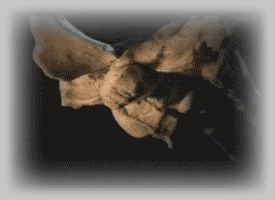
The Tympanic
Source: Evolution, Triumph of an Idea, Carl Zimmer
"One particularly baffling fossil was the back part of a 50-million-year-old skull. It was about the size of a coyote's and had a high ridge running like a mohawk over the top of its head, where muscles could attach and give the mammal a powerful bite. When Gingrich looked underneath the skull, he saw ear bones. They were two shells shaped like a pair of grapes and were anchored to the skull by bones in the shape of an S. For a paleontologist like Gingerich, these ear bones were a shock. Only the ear bones of whales have such a structure; no other vertebrate possesses them."
- Carl Zimmer
Around a million years after Pakicetus appeared, another relative emerged. Ambulocetus natans was discovered in Pakistan in 1994, by Dr. J.G.M. 'Hans' Thewissen. Ambulocetus natans means "the walking, swimming whale". Ambulocetus had thick, splayed-out legs, four-toed feet and a small hoof at the end of each toe. The creature possessed sharp teeth and was roughly the size of a large sea lion. Ambulocetus may have been an ambush-hunter, similar to the hunting style of modern crocodiles.
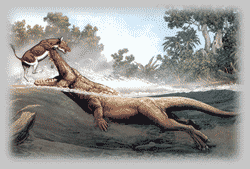
In a painting by Carl Buell, Ambulocetus, a 45 million year old whale, still retained the legs of its ancestors. It may have lived like an alligator, basking on land and ambushing in the water.
Source: Evolution, Triumph of an Idea, Carl Zimmer
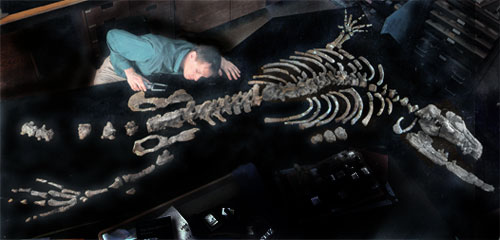
Dr. Thewissen examining the Pelvis of AmbulocetusAmbulocetus natans, the 49 million year old "walking, swimming whale" discovered in Pakistan by Thewissen and team in 1992, and described in 1994-1996, is currently the oldest known saltwater cetacean. "With long hind legs and hands, but the teeth and ears of a more modern whale, this animal was on the fence between land and sea."
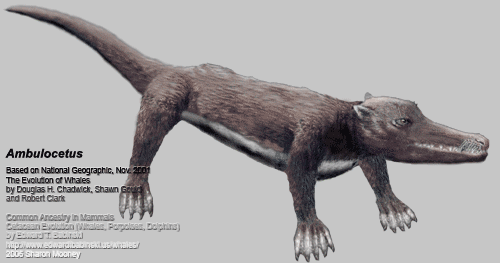
49 million years ago
Ambulocetus
The author tells of meeting Thewissen again, who is accompanied by an early whale expert, Sunil Bajpai, this time on a desert plain in western India, Rann of Kutch. Around 42-45 million earlier Kutch was border to a river delta, periodically filled by waters from the Indian Ocean. It was a place filled with sharks, rays, bony fish, crocodiles and turtles, and also early whales.
Some of the early whales found in this region have been Indocetus, Rodhocetus, Andrewsiphius and Kutchicetus. These early whales were no bigger than about 5 to 15 feet long and resembled large-headed, snaggle-toothed, web-footed sea lions or walruses and, similar to these modern species, may have returned to land to mate, birth, and moving about on short hind legs. However, recent analyses on oxygen isotopes in their teeth indicated they no longer needed to drink fresh water like Pakicetus. These particular successors of Ambulocetus had made significant metabolic change toward becoming true marine mammals.

Nasal Drift in Early Whales
Whales breathed with more ease when they no longer had to lift a snout above water. The nostrils migrated upward toward the top of their head, as ancient whales spent more time immersed in the water. Blowholes help to distinguish modern forms of whales. While toothed whales generally have one hole, baleens are split into two.
Fig 1. Pakicetus
Fig 2. Rodhocetus nostrils were higher on the skull, intermediate between its ancestors and modern whales.
Fig 3. A modern gray whale can emerge from the water, inhale and resubmerge without stopping or tilting its snout to breathe.
The spinal column of these creatures became more flexible and powerful, with the dwindling of rear limbs and hip bones. Their necks shortened, allowing the creatures to swim through the water with less drag and arms became like rudders. Having less need for outer ears, some were picking up sound underwater, through their lower jawbones, transmitted to the inner ear by specialized fat pads. With each new species of whale, they became more streamlined and ventured farther from shore. This transition took place in less than ten million years. According to Thewissen, "Whales underwent the most dramatic and complete transformation of any mammal. The early stages were so poorly known 15 years ago that creationists held up whales as proof that species couldn't possibly have come through natural selection. Now whales are one of the better examples of evolution."
The author describes prying a partial skull from the rubble, and Bajpai identifies the fragment as belonging to Remingtonocetus, by its long, narrow jaws. "We assume they were snapping up fish, like the modern gharial crocodile does with its needle-like snout," he said. "It is a specialization that appears several times among later cetaceans, including modern river dolphins."
Around 40 million years ago, ancient whales spread out from the Tethys Sea, which is considered the cradle of whale evolution, a group known as Dorudontines arose. These creatures could still bend their flippers at the elbow, and their nostrils had transitioned only partially up the snout to the top of the head. For the most part they were fully-fledged fluked cetaceans who gave birth at sea and may have been the group who gave rise to modern whales.
The author of Evolution of Whales interviews Paleontologist James Goedert about he and his wife's twenty years searching for remains of the early whales. The two have primarily been searching for fossils in the epoch following the Eocene, the Oligocene, from 34 million to 24 million years ago. "When we began, there were archaeocetes, or ancient whales, and then there were recognizable baleen and toothed whales. What came in between? The Oligocene, and it was pretty much a big blank. If you find a whale from this time period, chances are its a new species or even a whole new family. And when I do find one, there's no feeling like it." The Goederts' work has produced the oldest odontocete, several of the earlier mysticetes, and the Northern Pacific's oldest whale. The author journeys with Goedert into an area which contains fossils of the early whales. Geological forces had compressed bottom sediments of the early ocean into stone, then later they were thrust up on the continent's edge to be eroded by rainstorms and waves. The work to recover fossilized remains was already done.
The author comes across a fossil, to which Goedert says "You're looking at a very primitive true toothed whale." It was a link between ancient whales which carried a mixture of teeth shapes, legacy to their days on land, and odontocetes (the division with sperm whales, dolphins and their kin), whose teeth are more uniform, like spear tips or pegs. A more important observation in the transitional animal were in the architecture of the skull. Beginnings of special sacs off the main nasal passage for moving air back and forth to create sound vibrations and a lens of fatty tissue, or the melon, in the whale's forehead, used for focusing outgoing sounds and thinned portions in the area of the lower jaw, which aided in reception of sound vibration. Combined, they provided the ability to successfully navigate and find prey through echolocation, especially successful for toothed whales, odontocetes.

Evolution of Echolocation
Discoveries in fossil finds of early whales demonstrate that whales acquired underwater hearing, as were other traits, in stages. Pakicetus lacks the fat pad extending to the middle ear which modern Cetacea have. Later whales acquired the fat pad and jawbone adapted for reception of sound. However, the melon, evolved only in odontocetes, or toothed whales. In Basilosaurus, sounds transmitted to the middle ear as vibration from the lower jaw. Odontocetes (toothed whales) echolocate, the melon directs sound outward and the lower jaw works as a receptor.Researchers Discover Clues to Whale Evolution
May 8, 2002
A team of international scientists, including Hans Thewissen, an anatomist and paleontologist at the Northeastern Ohio Universities College of Medicine (NEOUCOM), has discovered that the inner ear of whales evolved much more quickly than expected, allowing the animals to become fully aquatic early in their evolution. The team's research, funded by the National Science Foundation (NSF), shows that the semicircular canals, the organ responsible for balance and located in the inner ear, was adapted to aquatic life approximately 45 million years ago. The discovery was published in the May 9 issue of the journal Nature.
Cetaceans (whales, dolphins and porpoises) have unique semicircular canals that allow them to be highly acrobatic swimmers without becoming dizzy. By investigating this organ in ancient fossils, the researchers found that early whales acquired this special trait quickly and early on in their evolution. This was a defining event that likely resulted in their total independence of life on land."The early evolutionary development of small semicircular canals by cetaceans opened an entirely new mammalian niche for habitation and contributed to the broad diversity of marine living habits that we see in whales today," said Rich Lane, director of NSF's paleontology program, which funded the research. "The evolutionary acquisition of such specialized organs or abilities (like the brain and upright walking habit of man) provide mechanisms by which highly evolved organisms dominate in certain environments."The researchers found that in living cetaceans the semicircular canals are much smaller than in any other mammal of the same body size. In fact, the semicircular canals of the huge blue whale are smaller than those of humans. In general, cetaceans are more acrobatic than similarly sized land animals (imagine an elephant making the jumps of a similar-sized whale). This could be the result of the small canals, because the small size makes the canals less sensitive, preventing the animal from becoming dizzy (i.e. experiencing vertigo).
Source: National Science Foundation

Rodhocetus
46.5 million years ago
"Rodhocetus is one of several extinct whale genera that possess land mammal characteristics, thus demonstrating the transition from land to sea that whales went through. The first species to be discovered (Rodhocetus kasrani) already exhibited such features as a large pelvis fused to the vertebrae, hind legs, and differentiated teeth. Of a recently discovered species (Rodhocetus balochistanensis), the ankle bones were recovered, further strengthening the already well-founded link to artiodactyls, but supposedly weakening the link to mesonychids. Rodhocetus balochistanensis is in fact believed to demonstrate a direct evolutionary link to artiodactyls (modern examples of which are hippopotamuses and pigs). This has largely overturned previous fossil-based theories that whales were directly descended from mesonychids, though it matches studies of the genetic relations between whales and other animals... the structure of the ankle bones of this species, which shows peculiarities known only in artiodactyls, and their ear bones, which are particularly like those of modern whales. The first fossils of this species were found in Balochistan Province, Pakistan in 2001 by Philip Gingerich. Dating from about 47 million years ago, they are one of a series of recent discoveries, including the pakicetids, which have thrown considerable light on the previously mysterious evolutionary origin of whales."
Rodhocetus Wikipedia
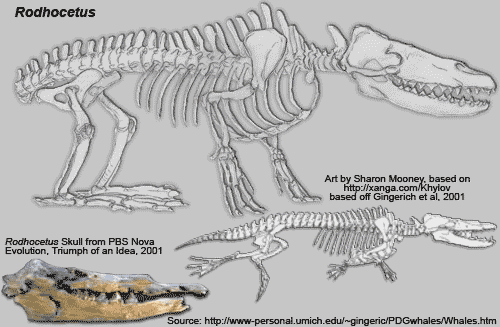
Fossil of whale that walked on land found in Pakistan
By Sally Pobojewski, News and Information Services
Fossils of a 46-million-year-old whale that walked on four legs on land, but swam with the undulating, up-and-down tail motion of a modern whale, have been discovered in Pakistan by paleontologist Philip D. Gingerich and researchers from the Geological Survey of Pakistan.
The discovery was announced in the April 28 issue of Nature.
Named Rodhocetus kasrani, the whale provides important information about structural and behavioral changes that occurred 40 to 50 million years ago as whales made the transition from land-dwelling to ocean-dwelling mammals.
“Rodhocetus is the first early whale found with a complete thoracic, lumbar and sacral vertebral column,” said Gingerich, director of the Museum of Paleontology and professor of geological sciences. “It retains primitive features seen in land mammals, but also exhibits derived characteristics found only in later ocean-dwelling species. It is an excellent candidate for a direct ancestor of modern whales.”
With its pointed snout, sharp teeth, short legs and robust tail, Rodhocetus may have looked something like a 10-foot-long crocodile with fur. According to Gingerich, it is the oldest whale ever found with the flexible back and heavily muscled tail needed for efficient swimming. “This shows that tail swimming similar to that of modern whales evolved early in cetacean history,” Gingerich said.
Rodhocetus’ fossilized remains were found during a 1992 excavation in northern Pakistan. The excavation site is now a rocky, mountainous desert, but 50 million years ago, it was located beneath the southern edge of an immense, ancient ocean called the Tethys Sea.“Whales are a classic example of fundamental changes being driven by evolution,” Gingerich said. “Over a 10-million-year period, whales gradually adapted in ways that allowed them to spend longer periods in the water and catch more fish.” Since good swimmers were more likely to live and reproduce, physical changes that improved swimming ability were more likely to be passed on to later generations.
Source: The University Record, May 9, 1994

Protocetus
45 million years ago
The original illustration in National Geographic, November 2001 "The Evolution of Whales", was labeled "Procetus". According to two of the foremost experts on early whales, Dr. Phil Gingerich and Dr. J.G.M. 'Hans' Thewissen, the caption should have read "Protocetus".
Dr. J.G.M. Thewissen: It is possible that someone by accident used Procetus for Protocetus, but that must have been a mistake. Protocetus is very poorly known, no limbs, no tail, no lower jaw, just a skull and a bunch of vertebrae. Protocetus was for years the best known cetacean (hence it was described as well known) but no limbs for it were known (and are still not known). For Protocetids, there are limbs and feet. Protocetids are a bigger group than Protocetus. Protocetids include Protocetus, but also Rodhocetus, Artiocetus, Indocetus, Georgiacetus, and some of those have better skeletons. So at this point some whales are better known.
Dr. Philip Gingerich: This was a misprint in the National Geographic magazine. Procetus must be a mistake and they're referring to Protocetus.
Q. With few fossil remains, how would scientists know whether or not to classify a fossil among whales?
A. It would qualify as a whale because of the general shape of the skull, position of the nose/blowhole and position of the ears.
-Mike (talk origins)Protocetus
"Protocetids for which most of the skeleton is known had large feet which they used in swimming, similar to Ambulocetus. However, it is possible that other protocetids had a tailfluke. Unlike remingtonocetids and ambulocetids, protocetids had large eyes that were laterally placed in the head under a large bony extension of the frontal bone (the supraorbital plate).
First whales to disperse widely across the world's oceans
Protocetids are a heterogeneous group of whales that lived in the Eocene, from approximately 48 to 35 million years ago. Protocetids postdate pakicetids and ambulocetids and predate most basilosaurids and dorudontids. In Pakistan and India, protocetids are found in combination with remingtonocetids. Protocetids were the first whales to leave the Indian Subcontinent and disperse to all shallow (sub)tropical oceans of the world. In addition to Indo-Pakistan, they are also known from Africa and the east coast of North America.
Source: Thewissen Lab Page, Protocetids
Redrawn from Gingerich et al. (2001a). (B) Early middle Eocene archaeocete Protocetus atavus. Modified from Fordyce and Muizon (2001).The best known of the early middle Eocene protocetids are Protocetus Fraas (1904), Rodhocetus Gingerich et al. (1994), Artiocetus Gingerich et al. (2001a), and Qaisracetus Gingerich al. (2001b), and the best known late middle Eocene protocetid is Georgiacetus Hulbert et al. (1998). Postcranial remains attributed to Indocetus by Gingerich et al. (1993) are now known to belong to Remingtonocetus. Skulls of Artiocetus and Protocetus are shown in Fig. 15.2 to illustrate their generalized mammalian form, with none of the anteroposterior foreshortening in the intertemporal region of the skull seen in mysticetes and odontocetes. Morphological characteristics of Protocetidae are listed in Table 15.5. The skeleton of the early protocetid Rodhocetus is illustrated in Fig. 15.3B, based on the skull and axial skeleton of Rodhocetus kasranii (Gingerich et al., 1994) and fore and hindlimbs of R. balochistanensis (Gingerich et al., 2001a). As whole, the early protocetid skeleton retains more generalized mammalian proportions compared to those of later basilosaurids, mysticetes, and odontocetes. The vertebral formula is known from several individuals to be 7:13:6:4:x (the number of caudal vertebrae in the tail is not yet known).
The neck is relatively long for a cetacean, and the anterior thoracic vertebrae retain high neural spines, like those of land mammals (e.g., Elomeryx in Fig. 15.3A). There are distinct anticlinal and diaphragmatic vertebrae in the posterior thoracic series. The centra of the sacrum are solidly co-ossified in some early protocetids and less so in others. The vertebrae at the base of the tail are robust, but neither the number of caudals nor the length of the tail is known. The scapula is narrow, like that of land mammals. The humerus is relatively long, and bones of the forearm are relatively short. The manus retains five digits, of which the central three retain small, flattened, hooflike ungules (Gingerich et al., 2001a).
Cetacea, Chapter 15, Philip D. Gingerich

Remingtonocetid Kutchicetus
43-46 million years ago
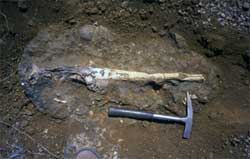 Images of skulls of Remingtonocetus, still embedded in the rock in which they were found, in Kachchh, India.
Images of skulls of Remingtonocetus, still embedded in the rock in which they were found, in Kachchh, India.
"Remingtonocetids are fossil whales that lived in South Asia, approximately from 49-43 million years ago. Their heads were very different from other whales. Their eyes were small, their snout long, and they had ears that transmitted sound similarly to those of modern whales. Remingtonocetids had long fore- and hind limbs. The reconstruction of Kutchicetus is based on the bones. It was a small animal, no bigger than a river otter."
Source: Remingtonocetidae - Whales Endemic to the Indian Subcontinent
Middle ear of the fossil whale Remingtonocetus from India
Credit: Artwork by Lauren StevensApproximately 43-46 million years old. The tympanic bone is seen from above, as it is cradling two of the ear ossicles, the malleus and incus (blue and green respectively, in false colors).
Evolution of Whale Hearing Unfolds in Fossil Record
August 11, 2004
ARLINGTON, Va.—An international team of scientists has traced the evolution of hearing in modern cetaceans (whales, dolphins and porpoises). "This study of the early evolution of whales demonstrates the changes that took place in whales' outer and middle ears, required for the transition from a land-based to a marine-based existence," said Rich Lane, director of the National Science Foundation (NSF)'s geology and paleontology program. The ear is the most important sense organ for modern toothed whales, say scientists, because these whales locate their prey using echolocation. Directional hearing is critical: A blind such whale could find food without much trouble; a deaf one would starve. The study documents how hearing in these whales evolved. The research is based on cetacean fossils representing four groups of early whales. The earliest cetaceans, pakicetids (those that swam in ancient seas 50 million years ago), used the same sound transmission system as did land mammals, and so had poor underwater hearing. More recent cetaceans, remingtonocetids and protocetids (those that lived 43-46 million years ago), retained the land-mammal system, but also developed a new sound transmission system. "The fossils document the ways in which cetacean hearing has changed, starting with ear fossils of whales' land ancestors and ending with the ear of near-modern looking whales," said Hans Thewissen, an anatomist at the Northeastern Ohio Universities College of Medicine (NEOUCOM). Thewissen and NEOUCOM researcher Sirpa Nummela led the study. The newer system was similar to that of modern whales. The later whales could hear better in water than pakicetids could, and could also hear in air, but hearing in both media was compromised by the existence of two systems. With the advent of basilosauroids (approximately 40 million years ago), the old land-mammal ear disappeared, and the modern cetacean sound transmission system began its development.
Source: National Science Foundation
Hearing clue to whale evolution
Thursday, 12 August, 2004
The evolution of whales from four-legged land dwellers into streamlined swimmers has been traced in fossilized ears, the journal Nature reports. The ancestors of cetaceans (whales, dolphins and porpoises) slowly lost their ability to move around on land to become efficient swimmers. This shift is recorded in whale ears, as they evolve a sound transmission better able to hear underwater... Whales went through a stage where their hearing was crude in both air and water."In less than 15 million years, bodies of cetaceans evolved to adapt to life in the water. However, the change from living on land to living in water caused great problems for hearing," said co-author Hans Thewissen, associate professor of anatomy at Northeastern Ohio Universities College of Medicine.The earliest cetaceans, the pakicetids - which lived about 50 million years ago - used the same sound transmission system as land mammals and had poor underwater hearing. By 43 million years ago, their relatives the remingtonocetids and protocetids (which lived between 43 and 46 million years ago) had developed a new sound transmission system.
Source: BBC News
Reconstruction of the remingtonocetid Kutchicetus. by Carl Buell

Durodon
37 million years ago
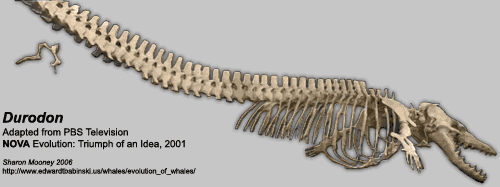
Basilosaurids and Dorudontids
Basilosaurids and dorudontids lived in the late Eocene, approximately 35 and 41 million years ago. They are mainly known from the eastern United States and from Egypt, but were probably worldwide in their distribution. Basilosaurids were enormous (possibly up to 60 feet long) and had long snake-like bodies. They had a tailfluke, but they probably swam using sinuous movements with their bodies. it is not clear whether that was the main propulsive organ. Fossilized stomach contents in one Basilosaurus indicates that it ate fish, including sharks. Dorudontids are closely related to basilosaurids but were proportionally more like dolphins. They probably swam using their fluke. Both basilosaurids and dorudontids had complete hindlimbs, that included a mobile knee and several toes. However these extremities were tiny, so small that they were certainly not important in aquatic propulsion.
Source: Thewissen Whale Origins WebpageDorudon
Dorudon was a genus of ancient cetacean that lived alongside Basilosaurus 40 to 36 million years ago, in the Eocene. They were about 5 metre long and were most likely carnivorous, feeding on small fish and mollusks. Dorudontids lived in warm seas around the world, fossils have been found in North America as well as in Egypt. Dorudontids were originally believed to be baby Basilosaurs as they were so similar, but have since been shown to be a different species with the discovery of Dorudon babies. Although they look very much like modern whales, basilosaurids and dorudontids lacked the 'melon organ' that allows their descendants to sing and use ultrasound as effectively as modern whales.
Source: Answers.com - DorudonLand-to-sea transition in early whales: evolution of Eocene Archaeoceti (Cetacea) in relation to skeletal proportions and locomotion of living semiaquatic mammals
GINGERICH Philip D. ; Paleontological Society
Skeletal remains of Eocene Archaeoceti provide the only direct and unequivocal evidence of the evolutionary transition of whales from land to sea. Archaeocete skeletons complete enough to be informative about locomotion are rare (principally Rodhocetus and Dorudon), and these deserve to be studied in comparison to the full spectrum of semiaquatic mammals. ... Mammals that are more aquatic have a shorter ilium and femur combined with longer manual and pedal phalanges, whereas the reverse is true for more terrestrial taxa... Trunk and limb proportions of late middle Eocene Dorudon indicate that it was a lumbus-and-tail-powered swimmer specialized in the direction of modern whales. Thus it appears that the land-to-sea transition in whale evolution involved at least two distinct phases of locomotor specialization: (1) hindlimb domination for drag-based pelvic paddling in protocetids (Rodhocetus), with tail elongation for stability, followed by (2) lumbus domination for lift-based caudal undulation and oscillation in basilosaurids (Dorudon). Rates of evolution in both phases of this change of adaptive zone are about an order of magnitude higher than background rates for the timescale involved.
Source: Philip D. Gingerich

Basilosaurus
37 million years ago
The author of Evolution of Whales, comments on Basilosaurus. In all likeliness it was a fierce hunter, the fossilized contents of one of the creatures' fossilized stomachs revealed 13 varieties of fish and sharks up to three feet long.
See Segment 3: Evolution of Whales (below, from PBS NOVA Evolution of Whales) for a complete overview on the discoveries of Basilosaurus and discovery of limbs on whales.
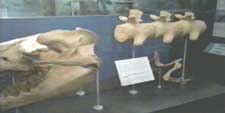
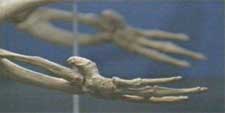
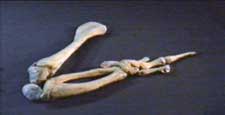
Source: PBS NOVA, Evolution, 2001

Aetiocetus
24-26 million years ago
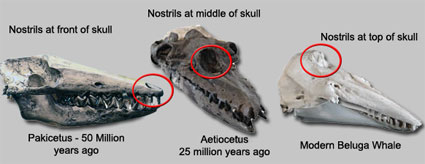
Nasal Drift in Whales: Aetiocetus an Intermediate
Transitional Forms
Fossils or organisms that show the intermediate states between an ancestral form and that of its descendants are referred to as transitional forms. There are numerous examples of transitional forms in the fossil record, providing an abundance of evidence for change over time. Pakicetus (below left), is described as an early ancestor to modern whales. Although pakicetids were land mammals, it is clear that they are related to whales and dolphins based on a number of specializations of the ear, relating to hearing. The skull shown here displays nostrils at the front of the skull. A skull of the beluga whale that roams the seas today (below right) has its nostrils placed at the top of its skull. It would appear from these two specimens that the position of the nostril has changed over time and thus we would expect to see intermediate forms.
Source: Transitional Forms in the Fossil RecordBaleen whales have toothed ancestors
Toothed whales have full sets of teeth throughout their lives. Baleen whales, however, only possess teeth in the early fetal stage and lose them before birth. The possession of teeth in fetal baleen whales provides evidence of common ancestry with toothed whales and other mammals. In addition, fossil evidence indicates that the late Oligocene whale Aetiocetus (left), from Oregon, which is considered to be the earliest example of baleen whales, also bore a full set of teeth.
Source: Part II: Baleen Whales and AetiocetusThe Origins and Adaptations of Mysticetes
Mysticetes were quite diverse during Late Oligocene times (23-30 Ma). Toothed mysticetes are known from scattered localities (e.g. Aetiocetus, North Pacific; Mammaldon, Southwest Pacific). Also, by about 30 Ma, the first toothless baleen whales ("cetotheres") had evolved. Like modern species, these had baleen in the thin flat upper jaw and a cylindrical toothless lower jaw, but otherwise they were quite primitive in structure. For example, they had a blowhole nearer the skull tip than in modern whales, the ear region was less advanced, and the neck vertebrae were not particularly compressed. These early baleen whales probably included the ancestors of modern rorquals (gulpers). Other groups of baleen whales, now extinct, indicate early "ecological experiments" which disappeared for uncertain reasons.
Source: Robert Ewan FordycePaleontologist James Goedert pointed out the mineralized remains of aetiocetid, which helps to bridge the gap between ancient and baleen whales. This creature was about ten feet long, and had teeth, yet has signs from skin tissue on its widened upper jaw, indicating it was developing baleen plates. Modern baleen whales still retain traces of their teeth while in the womb, but their teeth are reabsorbed before birth. Baleen whales no longer need teeth, their heads have evolved into living nets. The evolution of long strips of baleen have did for them what echolocation has, for the toothed whales.
Another paleontologist led the author into an area, Sharktooth Hill near Bakersfield, California rich in Miocene fossils (24 to 5 million years ago). Barnes comments, "The site contains some 30 kinds of cetaceans, so the cast of characters was about as varied as a similar locale in modern times." Over the years, volunteers at this location have unearthed eight species of baleen whales called cetotheres. Relatively primitive, this line survived until three million years ago. They coexisted with modern bowheads and right whales, which arrived on the scene around 22 million years ago. Barnes explained one reason for their massive size, 80 tons of more, is that bowheads and right whales have evolved the longest, most elaborate baleen of any whales and use it to comb from the ocean's abundant plankton. As time progressed, the cetotheres were succeeded by the family of rorquals, who were sleeker in build and faster in movement. Modern rorquals include behemoths as blue and sei whales. Pleats exist on the rorquals' underside allowing its throat to expand like an accordion when it gulps from food-rich water.
Sharktooth Hill has also yielded two varieties of sperm whale, a half dozen primitive dolphins called kentriodontids and the earliest delphinoids, as members of modern dolphins are known.

Squalodon
16 million years ago
Early Echolocation
A picture of the squalodon skull
Public display at the Smithsonian Museum of Natural History in Washington DC.Squalodon calvertensis, long-snouted shark toothed whale
Squalodons lived from the early-middle Oligocene into the middle Miocene, roughly 33 to 14 million years ago. The squalodon genus belongs to the Odontocete Order, the toothed whales. Specifically it belongs to the Squalodontidae superfamily. This superfamily is named after the shark squallus, since its' cheek teeth superficially resemble the teeth of a squallus shark; hence the name "shark toothed whale". The Squalodontidae superfamily contains three different groups of medium-sized (roughly 3 meters in length) shark toothed whales. They are the short-snouted shark toothed whales (prososqualodon), the medium-snouted shark toothed whales (phoberodon), and the long-snouted shark toothed whales. This last group contains the genus squalodon.
A strange mix of archaic and modern features characterizes this interesting superfamily. One of the most noticeable archaic features is their complex dentition. While other toothed whales were evolving simple conical teeth at this time, Squalodontidae retained their primitive teeth that their ancestors (the archaeocetis) had. For example their dentition is complex, their teeth are widely spaced apart, and their cheek teeth are triangular and serrated for grasping and cutting.
Despite these ancient features on Squalodontidae, they also had a mix of modern characteristics. For example, their craniums were well compressed, as their rostrums were telescoped outward, giving the appearance of modern toothed whales. Finally, squalodon skulls show evidence for the first appearance of echolocation.
Notice the front teeth protruding from the jaw, creating small "tusks."Source: www.fossilguy.com
Shark-toothed dolphins (Family Squalodontidae)
Shark-toothed dolphins are large extinct odontocetes with long narrow jaws and teeth that vary markedly from front to back in the jaws. These animals – the squalodontids - were widespread and diverse in the Late Oligocene and the Early to Middle Miocene (about 28 to 15 million years ago), but then disappeared. J-P-S Grateloup, a French scientist, proposed the name Squalodon for a fragment of jaw in 1840. Grateloup thought that the fossil might represent a reptile. Later finds from around the North Atlantic revealed that these animals were mammals, with skulls somewhat like those of living odontocetes - the toothed whales, dolphins and porpoises. However, the teeth were unlike any modern species. Living odontocetes typically have simple conical teeth that don’t vary much from front to back in the jaws, but squalodontid teeth are differentiated: at the tip of the jaw are incisors with conical crowns, which grade back into teeth with lower crowns and small, multiple denticles or cusps. Similarly differentiated teeth occur in archaic or ancestral cetaceans, the Archaeoceti.Eventually, the shark-toothed dolphins were placed in their own family, Squalodontidae. By 1923, when Dr Remington Kellogg reviewed the family, specimens had been reported from many parts of the world. Some squalodontids were known from rather complete skulls, such as represented by Squalodon calvertensis from Miocene rocks of Chesapeake Bay region, but most were reported only from one or a few isolated teeth. Despite the incomplete nature of many specimens, some were used as the basis for new species and genera. (Some of the teeth might not even represent odontocetes, let alone squalodontids.) In the 1960s, Prof.-Dr Karlheinz Rothausen (then of Johannes-Gutenberg University, Mainz, Germany) reviewed the group in several articles. For many decades, it was thought that squalodontids represented a stock from which many or most living odontocete groups evolved. In the late 1980s, Dr Christian de Muizon concluded that squalodontids are related closer to the endangered living Ganges dolphin, Platanista gangetica, than to any other living species. De Muizon based his assessment of relationships particularly on the scapula (shoulder blade) and also on the ear region. It is likely the squalodontids have little to do with the ancestry of most living dolphins. In the 1990s, Ewan Fordyce found a fossil dolphin – later named Waipatia - with superficially squalodontid-like teeth. Formerly, as Kellogg 1923 showed, such dolphins had indeed been identified as squalodontids. In 1994, Waipatia was named and put in a new group, Waipatiidae, separate from but related to the original squalodontids. It is now accepted that ancient dolphins with differentiated teeth belong in various families, not only the Squalodontidae.
Source: R.Ewan FordyceEcholocation
Seawater is eight hundred times denser than air and transmits sound more efficiently as a medium. Sound travels almost 5.5 times further in water than in air and cetaceans use their watery world to produce a variety of vocalizations, clicks, whistles, and calls. The resident populations of orcas in this region have developed their own unique dialect, or form of language. Toothed whales echolocate by producing a series of clicks that are emitted at various frequencies. These sound pulses are emitted through the whale’s melon-shaped forehead, reflect off objects, and are retrieved through their lower jaw which has a foam-like construction. Whales “read” the reflected sound similar to the way we read reflected light with our eyes. Baleen whales use low frequencies to communicate, sometimes over long distances. Marine mammals utilize a wide variety of physical behaviors to communicate. They use subtle or dynamic displays to signal others, herd prey, issue a warning, or to help dislodge parasites.
Source: Washington UniversityEncephalization is defined as the amount of brain mass exceeding that related to an animal's total body mass. Quantifying an animal's encephalization has been argued to be directly related to that animal's level of intelligence. In fact, as early as 1871, Charles Darwin wrote in his book `The Descent of Man': "No one, I presume, doubts that the large proportion which the size of man's brain bears to his body, compared to the same proportion in the gorilla or orang, is closely connected with his mental powers."
Source: Encephalization - WikipediaOrigin and Evolution of Large Brains in Toothed Whales
Another major hypothesis regarding the high encephalization in toothed whales focuses on the neural processing needs associated with either echolocation per se or its elaboration into a complex perceptual system in the sub-order Odontoceti (Jerison, 1986; Ridgway, 1986; Oelschläger, 1990). Results here show an increase in encephalization at the origin of Odontoceti that may be related to the emergence and elaboration of the ability to process high-frequency acoustic information associated with echolocation. Echolocation is an ability found in all modern odontocetes, thought to have existed in all known fossil odontocetes (Fleischer, 1976; Fordyce and de Muizon, 2001) and to have been absent in all archaeocetes (Uhen, 2004). Further investigations of echolocatory abilities are currently being undertaken in odontocetes and mysticetes to explore the relationship between changes in encephalization and perception of high-frequency sound as indicated by study of the fine scale anatomy of the internal periotic.
Source: Origin and Evolution of Large Brains in Toothed Whales
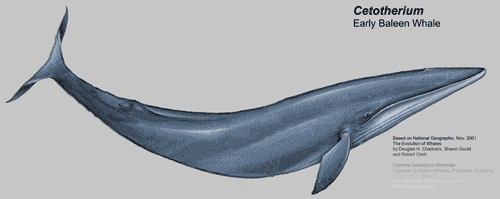
Cetotherium
15 million years ago
120 cm cetothere skull from the middle Miocene
Encyclopedia of Marine MammalsWilliam F. Perrin, Bernd Wursig, J.G.M. ThewissenEmergence of Modern Mysticete Fauna
The first members of some modern groups appeared in the middle part of the Miocene. These faunal changes may be correlative with worldwide environmental change and physical changes in the oceans. Among these changes were the establishment of a West Antartic ice sheet, closure of the western opening of the Mediterranean Sea, and closure of the Indo-Pacific Seaway, all of which may have contributed to cooling, steeper temperature gradients and more complex ocean current patterns. In turn this would have resulted in a variety of pelagic habitats and increased partitioning of food resources. Thus in the same way that major changes in ocean currents resulting in the radiation of the "archaic" mysticetes (cetotheres) during the early and middle Oligocene, another major shift in ocean currents and sea temperatures could have initiated the radiation of modern mysticetes and brought about the demise of the archaic forms.
It is generally thought that all four modern mysticete families have separate origins among the cetotheres, but this is still speculative. The modern baleen whales, [Balaenopteridae (rorquals and humpback whale, Megaptera novaengliae), Balaendia (right whales), Eschrichtiidae (gray whale, Eschrictius robustus), and Neobalaenidae (pygmy right whale, Caperea marginata) all have derived characters not presently known from any cetothere.
Source: Encyclopedia of Marine MammalsMysticete systematics and Evolution of Baleen Whales
There are three major cranial character suites that have been used to ascertain the relative degree of 'primitiveness' of fossil baleen-bearing whales. These are the position and shape of the occipital shield, the complexity of interdigitation between the bones of the rostrum (nasals, premaxillae and maxillae) and the braincase proper, and the slope angle of the supraorbital process of the frontal bone. Ancestrally, the occipital shield does not extend very far anteriorly, providing dorsal midline exposure of the parietals and frontals. The most primitive character state of this feature is seen on the various toothed mysticetes. In the most advanced character state, the occipital is in contact with the nasals and premaxillae on the vertex. This condition is found in modern balaenopterids, neobalaenids, but also in some cetotheres. The complex interdigitation of the bony sutures is clearly derived and is found in balaenopterids. Incipient interdigitation of the rostrum and braincase is seen in cetotheres and eschrichtiids. Modern balaenopoterids possess a supraorbital process of the frontal bone that is flat and horizontal until it reaches the braincase and then abruptly turns dorsally to the skull vertex. The result is a large region over the supraorbital process for the greatly enlarged temporalis muscle. The cetothere Cetotherium has distinct crests along the temporal ridge along the contact with the frontals, which Kellogg (1928) suggests to be a condition that foreshadows the state found in modern balaenopterids.
Although differing somewhat in detail, most morphologically based phylogenies of baleen whales as well as molecular based studies suggest that the balaenids were the first clade to diverge, followed by Neobalaenidae, and then the Eschrichtiidae and Balaenopteridae as sister taxa.
Source: Marine Mammal Biology: An Evolutionary Approach, A. Rus HoelzelMammals evolved on land, but by Miocene times many kinds had taken up life in the sea. Early whales had long snouts and four flipperlike legs, but later ones- such as Cetotherium-had front flippers only and a horizontal tail. Cetotherium fed by filtering small animals out of the water, just like most large whales do today.
Source: Mammal (DK/Google E.guides), by DK Publishing, 2005Mysticeti - Baleen whales
All living mysticetes are large filter-feeders although the exact means by which baleens are used vary among species (gulp-feeding for balaenopterids, skim-feeding for balaenids, and bottom ploughing for eschrichtiids).
The morphological modifications linked to filter-feeding are:
- Loss of functional teeth (vestigial teeth are lost before birth),
- Development of large body size and head,
- Shortening of the neck,
- Expanded maxillae (on which the epithelially-derived baleen plates develop),
- Mandibular rami only attached to each other by a ligament (at the symphysis).
The relationships among extinct and extant groups of mysticetes have been less extensively studied than the relationships among odontocetes. Four families are currently recognized: Balaenidae, Balaenopteridae, the Neobalaenidae (including a single extant species, the pygmy right whale, Caperea marginata), and the Eschrichtiidae (including a single extant species, the gray whale, Eschrichtius robustus).
Some molecular analyses positioned the skim-feeding balaenids (right whales) as the basal lineage of extant mysticetes (e.g., Arnason and Gulberg, 1994, 1996; Gatesy 1998). Uncertainty remains regarding the phylogenetic position of neobalaenids: Caperea might be the sister group to balaenopterids (rorquals) and Eschrichtius (gray whale) (Arnason and Gulberg 1994), or to balaenids (Gatesy 1998). This latter hypothesis is also supported by the morphological studies of McLeod et al. (1993) and Bisconti (2000).
Cetotheriidae is a very diverse paraphyletic family of Late Oligocene to Late Pliocene baleen-bearing whales. Many taxa are based on fragmentary material, leading to difficulties when trying to correlate taxa from distant fossil localities. Some cetotheriids exhibit character states reasonably interpreted as ancestral for balaenopterids (Mc Leod et al.1993; Kimura and Ozawa, 2002). Among Cetotheriidae s.l., Bouetel and Muizon (2006) isolate a monophyletic Cetotheriidae s.s., supported by a series of cranial characters and including six genera (Cetotherium, Herpetocetus, Metopocetus, Mixocetus, Nannocetus, and Piscobalaena).
Source: Mysticeti, Michel C. Milinkovitch and Olivier Lambert

Kentriodon
Early Dolphin
15 million years ago
Kentriodontine dolphins (Cetacea; Deiphinoidea; Kentriodontidae)
Fossil dolphins belonging to the extinct family Kentriodontidae are small to medium-sized toothed cetaceans, which probably include the ancestors of some living species. Kentriodontids are known from rocks of Late Oligocene to Late Miocene age in various parts of the world. Among kentriodontids, species in the subfamily Kentriodontinae (e.g. species of Kentriodon Kellogg, 1927) are the most ubiquitous and generalized; these are now known from latest Oligocene to earliest Miocene strata in New Zealand and Patagonia, and Middle Miocene deposits in Maryland, Virginia, California and Japan. The diversity, morphologies and distributions of Miocene species of Kentriodontinae seem to parallel those of the living species of mostly pelagic delphinids in the subfamily Delphininae, and the fossil group may have been an ecological or behavioral/functional counterpart of the latter. Kentriodontines are inferred to have been wide-ranging neritic to pelagic animals that ate small fish and other nectonic organisms; they were probably active echolocators, and might have formed large schools. They are relatively common as fossils and, therefore, are potentially useful for intercontinental correlations of marine deposits.
Kentriodontine dolphins (Cetacea; Deiphinoidea; Kentriodontidae)
Systematics and biogeography [Review]

Image Source: Vertebrate Paleontology, 2004, by M. J. Benton, after Kellogg, 1936
A new kentriodontine dolphin from the middle Miocene of Portugal
A nearly complete skull, a partial left scapula, five lumbar vertebrae, and some fragments of ribs of a medium-sized kentriodontid dolphin (Cetacea, Odontoceti) discovered in the middle Miocene of Setúbal Peninsula, Lower Tagus Basin, Portugal, are herein assigned to a new genus and species, Tagicetus joneti. Within the grade-level family Kentriodontidae, the new taxon is referred to the specifically and ecologically diversified subfamily Kentriodontinae, essentially defined by a well-developed posterolateral projection of the nasal. The elongated rostrum, the constriction of the asymmetric premaxillae at the base of the rostrum, the anteriorly elongated palatines, and the elevated vertex of T. joneti suggest closer affinities with the larger, more derived Macrokentriodon morani, from the middle Miocene of Maryland (USA). Among other features, T. joneti differs from the latter in having more numerous maxillary teeth and shorter zygomatic processes of the squamosals. Besides providing additional indications about the evolutionary trends within the Kentriodontinae, this occurrence constitutes the first record of the subfamily from the east coast of the North Atlantic based on a nearly complete skull. Considering their morphological diversity and wide geographic range, the Kentriodontinae may have constituted one of the dominant groups of Miocene oceanic dolphins.
Olivier Lambert, Mário Estevens, and Richard Smith
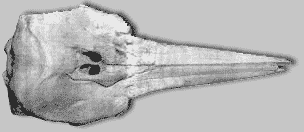
Odontocete cetaceans: Skull of Lomacetus ginsburgi (Miocene, Peru), dorsal view.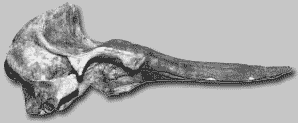
Skull of Albireo whistleri (Miocene, Isla Cedros), lateral view.
Image Source: Encyclopedia of Marine Mammals
by William F. Perrin (Editor), Bernd Wursig (Editor), J. G.M. Thewissen (Editor)
Evolution of Dolphins
Early true dolphins represent the grade family Kentriodontidae (Delphinoidea). Kentriodontids are geographically widespread small to medium-sized animals with largely symmetrical skulls, including Kentriodon and Hadrodelphis (both Calver Formation, Early to Middle Miocene, 14-16 million years ago). Rare Late Oligocene (>23 Million years) kentriodontids indicate ancient origins for the lineage leading to delphinids. The geologically youngest kentriodontids were contemporaneous with early delphinids from the Late Miocene (~10-12 million years ago), animals characterized particularly by markedly asymmetrical skulls.
(Supposedly older records of delphinids >12 million years ago, appear incorrect. Delphinids are important components of, especially, Pliocene assemblages (2-5 Million years ago). For example, fossils from northern Italy include skulls, teeth and ear bones referred to species Stenella, Tursiops, Orcinus, the Tursiops-like Hemisyntrachelus, and the extinct. Astadelphis.
Like delphinids, porpoises (Phocoenidae) and white whales (Monodontidae) range back to the Late Miocene, although no clear ancestors have been identified. The record of porpoises is better than that of monodontids, originating with Salumphocaena stocktoni from the eastern North Pacific (Monterey Formation, 10-11 Million years ago; California). Fossil ear bones and skulls indicate a high diversity for phocoenids in the latest Miocene and earlier Pliocene of the eastern Pacific (e.g., Lomocetus and Piscolithax. A more sparse record of monodontids reveals that this group was also important in warm equatorial waters of the eastern Pacific until well into the Pliocene, with fossils such as Denebola present in Peru and Cedros Island. In the Atlantic, Early Pliocene (~4.5 million years ago) Delphinapterus occurs in North Carolina (Yorktown formation) and there are reports of geologically young (Late Pleistocene <0.5 million years ago) Delphinapterus and Monodon from midlatitude North Atlantic shores.
While most of the Late Miocene and younger fossil delphinoids are of modern aspect, two extinct families are known from the latest Miocene and earlier Pliocene of the eastern Pacific. The Albireonidae is based on the latest Miocene porpoise-like Albireo whistleri from Cedros Island, whereas two species of tusked "walrus whales" (Odobenocetops; Odobenocetopsidae) are from the Pisco Formation. Peru. The latter are uncannily like the living walrus, Odobenus rosmarus, in skull form.
Several groups of river dolphin lie close to the Delphinoidea. Among members of these groups, pontoporiid fossils occur in freshwater strata in South America and Mid-Pliocene marine rocks bordering the eastern North Pacific and western North Atlantic. The small short-beaked Brachydelphis mazeasi (Pisco Formation, ~12-15 million years ago) from Peru represents a distinct subfamily (Pontoproriidae; Brachydelphininae) related to the long-beaked Peruvian fossil Pliopontos littoralis (~4-5 million years ago) and the living franciscana (Pontoporia blainvillei). Marine long-beaked species of Parapontoporia from Isla Cedros (Almejas Formation, ~5 million years ago) and southern California (San Diego Formation, ~2-3 million years ago) may be related to Pontoproia, although ear bone anatomy points to relationships with living baiji (Lipotes texillifer). The problematic Prolipotes, based on a fragment of possibly Miocene lower jaw from freshwater deposits in China, is too incomplete to confirm a relationship with Lipotes. Many fossils have been places in the family Iniidae, with the living Inia geoffrensis, but most of these belong elsewhere. Fossil iniids include the South American Late Miocene ("Mesopotamiense" horizon, >5 Ma) Ischyrorhynchus and probably Saurodelphis and may include the marine Goniodelphis hudsoni (Early Pliocene, 4-5 million years ago,) from Florida.Family Delphinidae: True Dolphins
Delphinidae are characterized by skull osteology; especially details of the left-skewed asymmetrical cranial vertex and narial region, the basicranium, and the periotic. Delphinids range from small to large species with long or short rostra, and narrow or broad rostra, and are the most diverse living family of Cetacea.
Source: Encyclopedia of Marine Mammals
by William F. Perrin (Editor), Bernd Wursig (Editor), J. G.M. Thewissen (Editor)From Primitive Odontocetes to Delphinidae
During the early Miocene, the melon developed in its modern form and the acoustic systems were refined. Various dolphin-like families, now extinct, flourished. The Squalodelphinidae were the earliest known odontocetes with asymmetrical skulls. Two taxa have been identified: Squalodelphis, from northern Italy, and Diochotichus, from Argentina. These creatures were small, probably less than three meters in length, and had many homodont teeth. The skulls were telescoped in a manner similar to the Rhabdosteidae and many derived species of Squalodonotidae. Some believe that the beaked whales evolved from this species, but there is limited evidence to support this. In modern times, the superfamily Delphinoidea contains most of the living cetacean species, including the families Delphinidae, Phocoenidae, and Monodontidae, as well as the now defunct families Albireonidae and Kentriodontidae, which are thought to be ancestors. Most members of the family Kentriodontidae were very small, with lengths only up to about two meters. They had short beaks and many homodont teeth. Although diverse during the Middle and Late Miocene in both the Atlantic and Pacific Oceans, there are no specimens less than ten million years old. The families Delphinidae, Phoceonidae, and Monodontidae are genetically very similar, with only a 10-15% variation in C-heterochromatin. Almost all have the same chromosome number, 2n=44. The one exception is the orca, with only one pair of t chromosomes, which has short arms and satellite structures. The m chromosomes are also very small in the Orca.
Evolution of DolphinsAdditional link of interest by the "fossilguy" on Kentriodon, and fossil remains [Fossils Found in the Calvert & Choptank formations at the Calvert Cliffs of Maryland].

Odobenocetops
Walrus-like Dolphin
5 million years ago
Family Odobenocetopsidae: Walrus-like Whales
Odobenocetops had asymmetrical, posteroventrally directed tusks, the right much longer than the other, similar to those of a narwhal, and a blunt snout. There were no upper teeth. The facial region retained the odontocete nasal morphology, but lacked the bony indications of nasal sacs and air sinuses. The optic nerve tracts were exceptionally large for a cetacean.
Reconstruction of Odobenocetops leptodon (males) in swimming and feeding position. The third individual in the background is in ventrolated view from the left side in order to show the erupted small left tusk. From Muizon et al. (1999). Painting by Mary Parrish (Smithsonian Institution, Washington, D.C.)

Odobenocetops peruvianus: Skull of a male in dorsal (A) ventral (B) lateral (C) anterior (D) views. 1993, Macmillion Magazines, Ltd.
The occurrence of tusks in Odobenocetops is a convergence with Monodon as in the latter genus the large tusk of the male is implanted in the left maxilla, whereas in Odobenocetops it is implanted in the right premaxilla. Consequently, the tusks of Monodon and Odobenocetops are not homologous.
Odobenocetops and Anatomy
Odobenocetops and the living walrus show several morphogical convergences; a large and deep palate; strong development of a wide, blunt snout, which is highly vascularized and innervated with strong muscular insertions, suggesting the presence of a powerful tactile upper lip; the presence of tusks; and a reduction of maxillary dentition (postcanine maxillary teeth are absent in the fossil walrus Valenictus chulavistensis. The living walrus feeds mainly on benthic invertebrates (e.g., Mya Clinocardium, Tellina, Spisula, Macoma) (Fay, 1982), sucking out the siphon and foot of bivalves and gastopods shells, using the tongue as a piston powered by the very large lingual restractors and depressors. Their mouth works like a powerful vaccuum pump. Given the anatomy of its palate, it is likely that Odobenocetops presented a similar feeding adaptation.
Vision and hearing were probably slightly different in the two species of Odobenocetops. O. leptodon fossae for premaxillary sacs are clearly present on the premaxillae, just anterior to the nares as are observed in other odonotocetes. The dorsal surface of the nostrum is longer and wider and there is enough space for a small melon anterior to the nares. The cetacean melon is related to echolocation. The probable lack of echolocation ability in O. peruvianus was probably compensated for by good anterodorsal binocular vision. As in the walrus, vision was especially useful when the animal was searching for food on the sea floor with the body in an oblique position. In O. leptodon, limited binocular vision was compensated for by echolocation ability as in other odontocetes.
Tusk, Position and Function
The tusks are certainly one of the most unusual characteristics of Odobenocetops. Because of its great length and slenderness, the right tusk of the male was probably very fragile and it was unlikely that the animal swam with the tusk held at 45 degree angle with the axis of the body. When feeding, the large tusk was dragged on the sea floor, and because of the oblique position of the body, the tusk was held at an angle of 20 to 40 degrees with the axis of the body. In other respects, the convexity of the occipital condyles of Odobenocetops indicates this its neck was extremely mobile, allowing a degree of head movement approaching 90 degrees or more.
The narwhal tusk is mainly used in social activities. The orientation and length of the large tusk of Odobenocetops suggest that this tooth was very fragile and was unlikely to have been used to exert forces (in digging or fighting). (Muizon et al., 2001).
Source: Encyclopedia of Marine Mammals
by William F. Perrin (Editor), Bernd Wursig (Editor), J. G.M. Thewissen (Editor)
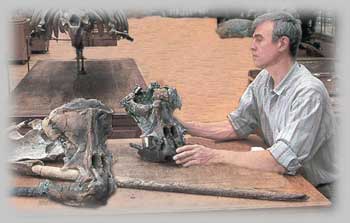
Christian de Muizon and Paris Muséum National d'Histoire Naturelle
"It's a lesson in convergent evolution." Examining the four million year old Odobenocetops, which was discovered in Peru. Such tusked walrus-like dolphins filled in a niche occupied elsewhere by early walruses.From the Miocene forward, whales could take advantage of an abundant food supply, from crustaceans and sardines to sea lions and giant squid. Barnes reminded the author, the evolution of cetaceans was not only about bigness, sharing a dolphin skull and pointing out how the bones of the snout extend over the brain case. It was a move related to the evolution of the fatty melon, and air sacs that help the dolphin in echolocation. In some species, the forehead has a concavity like a satellite dish, which helps to boost the creature's echolocation reception.
Questions Remain On Whale Evolution
- At what point did whales evolve extra myoglobin in their muscles, to store oxygen for long dives?
- When did Humpbacks begin singing?
Since changes in physiology are not always associated with apparent shifts in anatomy, they are harder to determine.The family tree belonging to whales is far from finished. Many branches contain gaps, that await to be filled in. Scientists have known since the 1880's whales and ruminants possess multichambered stomachs and similarities in a folding pattern on the cortex of the brain. Modern analysts have discovered matches on proteins and amino acids, shared between whales and artiodactyls, hoofed animals with an even number of toes, including ruminants, pigs and hippos. Ankle bones discovered by Philip Gingerich and colleagues described in a 2001 of Science, point to artiodactyl origins, as does the systematic analysis of pakicetid cetaceans by Thewissen and co-workers from 2001. Norihiro Okada, Institute of Technology, Japan, in fact believes hippos are the closest living relatives of whales. Okada and colleagues discovered unique genetic markers shared only by whales and hippos, which indicates common ancestry. He concludes, "It is the solution to a problem that has continued more than a century." If the conclusion of Okada is correct, that would mean whales descended from a group of early artiodactyls called anthracotheres, modestly sized creatures with piglike appearance and four hoofed toes on both feet, just as hippos have today. These creatures were common in Eurasia during the age of mammals, the anthracotheres lead to the rise of a number of marsh-dwelling forms.

Ambulocetus

Basilosaurus with well developed hind limbs, though reduced in size.

Sperm whales retain hind limb atavisms.
Losing their Legs
PPakicetus walked on land and waded in water, but Ambulocetus was more aquatic. It's pelvis was fused to its backbone, which allowed it to support its weight on land, while webbed feet gave it additional power underwater when it would swim, perhaps undulating its spine like an otter. Basilosaurus, snakelike and possessing shrunken legs, emerged on the scene some ten million years later. Some evidence indicates the reduced limbs may have been used in copulation. Today, hind rudiments are small and internal, acting as an anchor for genitalia muscles. The animals still retain genetic codes, for longer limbs. On occasion a whale may be born with a limb or two sprouted, known as an atavism.
The author of Evolution of Whales comments on his conversation with Lawrence Barnes, and recollection of a Pliocene dolphin, with blunt nose and squarish head, and long tusks resemble a mollusk eating walrus. This fossil provoked him to wonder just how many varieties of whales had existed since the most ancient species. Barnes confessed never adding them up, and suggested to try doing so. Left with the file card index, representing all identified cetacean species, around 1000 were counted. Barnes response was, "My guess is that represents ten percent of what's out there waiting to be dug up." Jim Goedert would say to keep looking, the world holds more miracles -- big, small, new and old -- than can be imagined.
Footnote
Edward T. Babinski: I'd just like to add that there are some creationists out there who aren't even phased by the loss of legs in cetaceans over time. They just chalk that up to "de-volution," degeneration. But at the same time these creationists don't even consider the major adaptations those same cetaceans underwent over time to enable them to live their entire lives in the ocean without using legs at all. All of those sea-going adaptations are far from being "devolution," but are examples of positive evolutionary traits. The evolution of the ear for increasing underwater hearing, the evolution of the fins and streamlining of the body for better swimming, the evolution of the position of the nostril from the nose's tip to the middle of the nose to the top of the head so that breathing is accomplished easier for a sea-going mammal. All in all, the anatomy of cetaceans also remains strikingly like the anatomy of their land-lubbing forebears, including the pelvis and vestigial femurs and tibias in right whales. Also, in some species of whales there's still two blow-holes in the tops of their heads rather than one, which is a remnant of the two nostrils that formerly existed. And in the forefins there remains the tendons and bones of the forelimb of their ancestors, but which move a lot less.
REFERENCES
- J.G.M. Thewissen, PhD, Whale Origins, Thewissen Lab
- Phil Gingerich, PhD, Research on the Origin and Early Evolution of Whales (Cetacea)
- Carl Zimmer, PBS Nova' Evolution: Triumph of an Idea
- PBS Evolution Project
Further Reading
- Evolution of Cetaceans
- PBS - Whale Evolution
- Whale Evolution
- Whale Evolution cladogram
- Land to Sea Transitionals, whales
- Whales, Philip Gingerich
- Evolution of Whales
- Primitive Whales
- Evolution of Whales
- Collection of Whale Evolution articles
- Whale Evolution
- Cetaceans Evolution
A Creationist Rebuttal
All images reconstructed from National Geographic, are public access, though source and appropriate credits must be left intact.
"It's a wonderful resource for teachers and students. Well done!"
--
John S. Wilkins, Postdoctoral Research Fellow, Biohumanities Project
University of Queensland - Blog: scienceblogs.com/evolvingthoughts
* Special thanks to Mike, Windy and Craig.


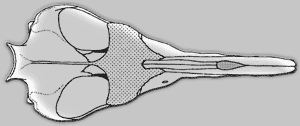
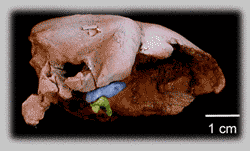
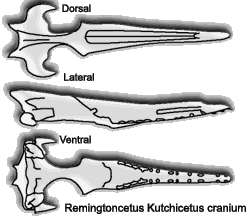
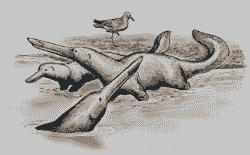


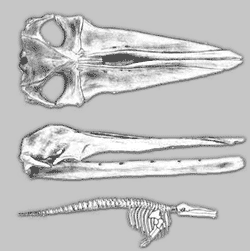
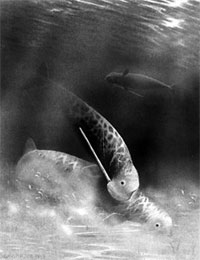
No comments:
Post a Comment